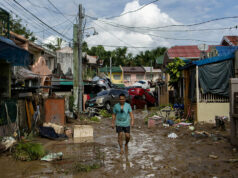Money Heist: A show that connects to the periphery of the world
WHEN it first aired on Spanish television channel Antena 3, La Casa de Papel, also known as Money Heist, was a failure: it had falling viewership and its creator álex Pina, the cast, and the crew thought it was over, that there was no hope for the series. But then it was picked up by Netflix and suddenly it became one of the most-streamed titles on the service globally and even won an Emmy award for Best Drama series in 2018.
“[The series was a failure.] It was like a zombie. [Viewership fell from] 4 million to 2 million. We were going to put an end to it. I couldn’t even convince my friends to watch it. And then Netflix bought it June 2017 and some months after, in December, they uploaded it,” Javier Goméz Santander, the show’s screenwriter and co-executive producer, said in a webinar organized by Instituto de Cervantes Manila on April 28.
(The webinar was done in Spanish with simultaneous English translation.)
He said they noticed that the series was getting traction in February when, during a football match in Saudi Arabia, the bleachers transformed into the show’s Salvador Dalí mask. Then the same mask sold out in Rio de Janeiro. There were also a few copycat crimes.
“It was more popular outside Spain,” Mr. Goméz Santander said.
Money Heist is, as its name suggests, a heist film, but it’s distinctive Spanish sensibilities made it different: from having the film told through a female perspective, to a focus on the emotional dynamics and passionate scenes distinctive of telenovelas, and dark comedy. Mr. Goméz Santander noted that the beauty of the series is it was told from “the periphery of the Anglo-Saxon world.”
“[The series is] more emotional… and we found ourselves an incredible platform which is our language. We discover that the periphery of the world… have a common vision,” he said before adding that it’s time to have more stories coming from the periphery (outside Hollywood) because “we’ve exhausted the Anglo-Saxon narrative.”
If there was one thing that he thinks Money Heist has successfully done is that he thinks the world will be seeing more “products from all the peripheries.”
Money Heist’s plot is fairly simple: the first season revolved around a plan to rob the Royal Mint of Spain, which involved the thieves taking 67 hostages, printing 2.4 billion euros, and then escaping. The entire plan was orchestrated and controlled by the Professor (álvaro Morte) from an external location. Each person in the group wore a red jumpsuit and a Salvador Dalí mask and went by a code name using cities (Tokyo, Moscow, Nairobi, etc).
The show was supposed to end there — its creator, álex Pina, initially planned for it to be a limited series. But then Netflix asked them to write another season, Mr. Pina said in the documentary Money Heist: The Phenomenon. He said it took them two months to get back to Netflix and make a second season.
(Each Money Heist season is divided into two parts. The most recent release was the second half of the second season on April.)
“The biggest decision was to decide to come back or not to come back. After the Mint, it was dead and it was done. But Netflix said if you want to reopen it then we’re game. We didn’t want to destroy that myth. It was very difficult,” Mr. Goméz Santander said in the webinar.
“You don’t write stories about people in paradise,” he added.
At the end of Season 1, the group managed to escape and celebrate their spoils. The Professor chose to vacation in Palawan. In the second season, he finds refuge in an undisclosed location in Mindanao. The second season also introduced a character who goes by the name Manila (played by Belén Cuesta), a transwoman who is the godchild of Moscow (Paco Tous) and Denver’s (Jaime Lorente) childhood friend.
The idea of including the Philippines in the show was sentimental, said Mr. Goméz Santander as Mr. Pina had been to the Philippines and had gone to Mindanao and loved it. It should be noted that the scenes which are supposedly set in Mindanao were actually shot in Madrid, though Mr. Goméz Santander said they did shoot a few scenes in the Philippines.
In the second season, the gang’s target is the Bank of Spain.
With much of the world currently under varying degrees of quarantine due to the COVID-19 pandemic — Spain has the second-most number of cases after the US at 236,899 so far — Mr. Goméz Santander said that much like the characters of Money Heist, “we need to accept a more intense world.”
“We put the characters [under so much pressure] — in jail and in a ship. Why we resort to this is to elevate the emotions with characters and viewers. [It’s like being in a] pressure cooker, everything is magnified. We now find ourselves in a very similar situation,” he said.
“And that has affected our mental health… it’s important that we are aware that we’re subject to this pressure and to be able to do as best [as we possibly can] to manage the situation,” he added. — Zsarlene B. Chua



